This guide is intended for solar suppliers, distributors and brokers who are selling PV equipment at wholesale levels. Whether you’re looking for ways to expand your reach or enhance your customer experience, this guide is for you.
The solar industry is well known for its established relationships. As industry professionals, you’ve probably worked hard to form and nurture partnerships with wholesale buyers. But are you fully reaching your potential as a wholesaler? Or, are there ways you can evolve and expand as a company?
Even if you’re feeling good about your marketing and sales strategies, business operations and customer support, you may want to gut-check yourself. Taking time to analyze your processes could identify costs and opportunities that you didn’t know were there.
This guide offers tips to boost your wholesale solar company to a new level of success. Our insights are based on more than twenty years’ experience connecting wholesale buyers and sellers via online B2B exchanges.
What does wholesale selling mean?
Wholesale selling is all about business-to-business (B2B) sales in bulk quantities. Because of the large volume, you are able to offer a sizable discount to your customers. The discount affords your customers the ability to add their margin before reselling the equipment to consumers or quoting the total price of the solar array to their customers.
Wholesalers typically require a minimum order quantity that customers must meet to qualify for a discount. You have probably also defined volume pricing levels to accommodate for residential, non-residential and utility-scale project sizes. The price of a 50 kW order will vary from that of a 50 MW order.
Wholesale seller business models
Wholesalers tend to take on one of the following business models. Regardless of your business model, keep in mind that all wholesalers are masters of distribution. This core competency attracts manufacturers, who desire to penetrate markets with their brands but prefer to stay focused on innovation rather than fulfilling customer orders.
Merchant or Stocking Wholesaler
Merchant wholesalers take title of the inventory. They may have multiple warehouses or one central storage facility. They stock a large number of SKUs and brands.
Distributor
Distributors are similar to merchant wholesalers except for one major difference. They choose to only represent a select number of brands. Distributors prefer to stock top brand names from manufacturers who have a stable track record and established bankability.
Agent Wholesaler
Agent wholesalers don’t take ownership of the inventory but rather represent manufacturers and other sellers. They facilitate transactions, including taking orders, negotiating contracts, scheduling delivery and collecting payment.
Reseller
A wholesale reseller is unique in the sense that they don’t always follow a traditional vertical supply chain. Rather, they tend to acquire goods from a variety of supplier relationships like manufacturers, other wholesalers, liquidators, auction houses, and even developers, EPCs and contractors with excess and second-hand material. They may work with solar equipment brokers to buy and sell goods as well.
 Read how a reseller found his niche as a surplus liquidator of stranded and distressed PV equipment.
Read how a reseller found his niche as a surplus liquidator of stranded and distressed PV equipment.
Many solar wholesalers and distributors have evolved their business models to offer value-added services. Some provide storage space to contractors and will drop ship equipment to project worksites. Some offer lines of credit. And some buy back excess and used equipment as long as the material has resale value. A number of suppliers are dedicated to making wholesale buying possible and accessible to all kinds of installers and resellers, regardless of their size and capacity.
 Review your options for selling excess, surplus, clearance, and used solar equipment to wholesale buyers.
Review your options for selling excess, surplus, clearance, and used solar equipment to wholesale buyers.
 Consider adding value to your customer experience by providing complimentary hardware audits and other asset disposition services.
Consider adding value to your customer experience by providing complimentary hardware audits and other asset disposition services.
Why sell wholesale?
There are many benefits to selling wholesale solar equipment. Ultimately, it’s good for business and for the advancement of solar worldwide.
- Lower priced arrays bring down the LCOE. When a solar system’s levelized cost of energy (LCOE) is competitive with or beats other fossil fuel sources, solar is justified as a viable energy source, especially when paired with storage and/or other renewable sources. The larger the array, the lower the overall cost per watt. The more affordable solar and storage become, the more accessible it is to all people, which is probably why you got into this business to begin with. Selling in bulk helps your company reach economies of scale so you can offer the lowest prices to your customers and participate in the advancement of solar worldwide.
- The vast majority of new solar growth is in the non-residential and utility markets. Over 70% of solar projects today are in these two markets. By Q3 2020, the U.S. had installed a record 11 GW of new solar capacity. Analysts forecast new installations from 2021-2025 to exceed 107 GWdc, which will be primarily driven by utility-scale projects. Even some residential installers have adopted wholesale buying to save money. Demand for bulk purchases will remain strong through these years.
- Larger, more consistent sales orders result in a higher average order value. Your revenues go up when you sell more volume. Plus, you experience an increased inventory turnover ratio. Your company also has the opportunity to reach and maintain economies of scale as you efficiently manage business operations.
- Your customer retention rate is higher with bulk orders. Large-scale orders open the door to developing long-term relationships with your customers. In the beginning, both you and the prospective buyer go to great lengths to conduct due diligence on each other. If everything checks out and the prospect is satisfied with your quote, they proceed with the order. Your follow-through on that first order leads to trust, and from that point on, you can nurture the relationship.
- Selling in bulk attracts manufacturers and other suppliers to you. The more you’re successful at selling others’ brands, the more they’ll give you preferential treatment when it comes to their capacities. Part of that success will surely rely on your regular customer base. But don’t get too comfortable. Every wholesaler needs to continuously work at finding new qualified buyers to increase your overall sales volume.
 Get tips to gain efficiency when adding an online sales channel to your sales strategy.
Get tips to gain efficiency when adding an online sales channel to your sales strategy.
 Read how wholesale sellers offset supply chain issues by doing business in the secondary solar market.
Read how wholesale sellers offset supply chain issues by doing business in the secondary solar market.
B2B marketing mix
Wholesaling is all about marketing. You may have heard of the four pillars of marketing – product, price, place and promotion – and maybe you’ve based your company strategies on these pillars. But the 4 P’s don’t seem to capture the value of the solutions that wholesalers offer.
Wouldn’t you rather be known in the solar industry as a trusted source of advice and problem-solving than just a salesforce of product technology and quality?
That’s where the re-constructed 4 P’s become SAVE, which is an acronym for solution, access, value and education. Not to say that the 4 P’s are irrelevant. On the contrary, they are redefined to better serve B2B marketers.
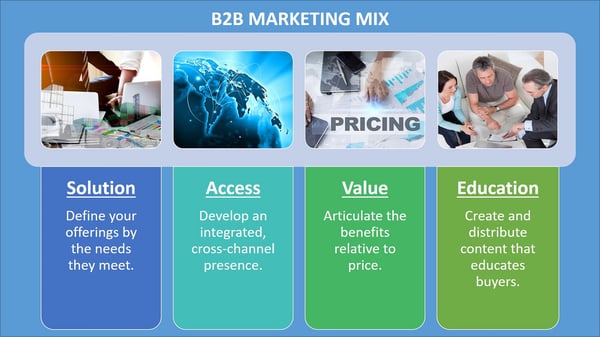
Solution – Define your offerings by the needs they meet, not by product features.
Wholesalers who succeed at thinking about solar projects in their entirety from inception to completion and perhaps even to end-of-life or repowering have an opportunity to develop solutions that comprehensively address their customer needs.
Having a plan in place for PV hardware resale is a key component to a holistic customer experience.
 Watch this video to learn about PV hardware trade trends.
Watch this video to learn about PV hardware trade trends.
 Learn about opportunities in solar panel reuse and recycling, secondary market solutions that add value to your customers' experience.
Learn about opportunities in solar panel reuse and recycling, secondary market solutions that add value to your customers' experience.
Access – Develop an integrated, cross-channel presence that takes into account the buyer’s journey (awareness, consideration and decision).
On the front end of the buyer’s journey, content – both online and in print – that targets customer needs and presents your brand offerings as possible solutions helps potential buyers become aware of your existence. Trade shows and other networking events are useful for face-to-face communication as well.
Most B2B marketers recognize that the buyer’s journey isn’t a clear-cut path. There can be a lot of twists and turns that can take time to reach a ‘decision’ destination. Being patient yet persistent with your messaging is key to customer acquisition.
Make online sales part of your cross-channel strategy. Listing your inventory for sale on multiple marketplaces will increase visibility and brand recognition.
 Get tips for selling your inventory on the EnergyBin exchange.
Get tips for selling your inventory on the EnergyBin exchange.
Value – Seek to articulate the benefits relative to price, rather than leading with how price relates to your production costs, profit margins or competitors’ prices.
Of course, you can’t go crazy and charge above what the market will support simply because you think your value is worth it. There are several factors to consider when pricing your goods.
Your wholesale price will be determined by the cost of the equipment – what you pay to your supplier – plus your value-added markup. Knowing what markup to add boils down to your market research.
- What is the supply-to-demand ratio? If demand outweighs supply, could you price the product higher?
- What are your customers willing to pay?
- What are your competitors charging?
One of the best ways to keep a pulse on the market is to join a wholesale solar B2B exchange. Exchanges, like EnergyBin, are market intelligence powerhouses that reveal what products are moving as well as low-average-high prices.
On EnergyBin, for example, you can analyze data based on product description, condition, location and other filters. The supply & demand feature also provides a list of members who recently searched for a part number or keyword that matches a product, which wholesale sellers can use as a lead generation list.
In addition to using data intelligence available on exchanges, stay up to date with industry reports and price indices. Both Lawrence Berkeley National Laboratory and Wood Mackenzie regularly publish reports that track pricing for the United States. PVXchange publishes a monthly module price index for the European Union.
 Read about market conditions that affect solar panel pricing and availability.
Read about market conditions that affect solar panel pricing and availability.
 Review trends that are driving module availability and pricing in the secondary market to grow your business.
Review trends that are driving module availability and pricing in the secondary market to grow your business.
 Read the 2024 PV Module Price Index presented by EnergyBin, which tracks prices of c-Si modules within the secondary market.
Read the 2024 PV Module Price Index presented by EnergyBin, which tracks prices of c-Si modules within the secondary market.
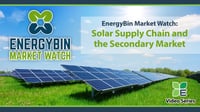 View the latest Market Watch discussion that covers solar supply chain issues and secondary market trends.
View the latest Market Watch discussion that covers solar supply chain issues and secondary market trends.
Education – Create and distribute content that educates buyers. Content should explain how your solutions address your buyers’ needs.
Education goes hand-in-hand with promotion. You’ve probably noticed many brands in the industry moving away from straight-up ads as they implement blogs, sponsored content, webinars, videos and podcasts. If they are still paying for ads, they’re doing so in conjunction with a content strategy.
When you produce and distribute consistent quality content, you become known in the industry as a thought leader on the subject of wholesaling. Buyers will know of you and will seek you out when they perceive you can help them with their needs.
 Learn how to create video content that engages prospects and customers without breaking your budget.
Learn how to create video content that engages prospects and customers without breaking your budget.
Five forces of competition
Another critical component of marketing is keeping tabs on your competitors. Whether you’re striving to gain or maintain market share, knowing your competitors’ goals, strategies, assumptions of the market and abilities to achieve their goals should be a part of your regular business operations.
The school of business recognizes five key forces that serve as the foundation of competitive landscape. When you understand the collective strength of these forces, you can determine your profit potential.
The five forces of competition are:
1. Threat of new entrants
2. Bargaining power of customers
3. Threat of substitute products/services
4. Bargaining power of suppliers
5. Jockeying for position among current competitors
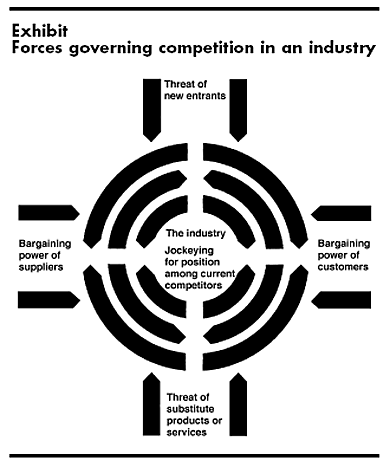
“Whatever their collective strength, the corporate strategist’s goal is to find a position in the industry where his or her company can best defend itself against these forces or can influence them in its favor,” advises Michael Porter, the creator of the five forces model and professor at Harvard Business School.
Studying these five forces with respect to the energy industry may open your eyes to competitors you aren’t aware of. Plus, you may see new opportunities that your company can take advantage of.
 Read more about how these forces play out in the solar industry, and learn new tricks to keep tabs on your competition.
Read more about how these forces play out in the solar industry, and learn new tricks to keep tabs on your competition.
 Broadcast your PV hardware for sale on EnergyBin to get ahead of your competitors.
Broadcast your PV hardware for sale on EnergyBin to get ahead of your competitors.
Factors to consider when selling wholesale
There are many factors to keep in mind when running a wholesale business. Your primary focus narrows down to increasing revenue and minimizing costs. Here are some key points to help you maintain your focus:
1. Do your research.
What products are your customers in the market for? You don’t want to get stuck with products that aren’t in demand. Nor do you want to get caught off guard by having too little supply of a hot product. If you aren’t prepared for buyers’ needs, they’ll run to your competitors.
Can you trace the supply chains of the products you stock to ensure they meet quality standards, corporate social responsibility requirements, environmental considerations, and applicable laws? Solar Energy Industries Association recommends that you ask manufacturers the following questions to become better informed about your supply chains:
- Do you follow the SEIA Traceability Protocol? If not, why not?
- Do you and your suppliers have a corporate social responsibility code of conduct or policy in place? If so, can you share it?
- Does your code of conduct address the areas covered by the International Labor Organization's core labor standards?
- Do you communicate your code of conduct to your suppliers?
- What steps do you take to ensure that you and your suppliers are in compliance with [region's] laws and regulations?
- Can you show where the product is manufactured and where the inputs come from?
- Can you provide the most recent independent audit reports regarding your claims?
- Who conducted the audit? Was it conducted by a qualified, independent third-party organization?
- Are the audits announced or unannounced? How often are audits conducted?
At what times in the year do large orders come in? Review the seasonality of your sales history to determine if there are certain times when order variances occur. Watch industry trends as well, including solar policies that could affect buyer behavior.
What needs to happen internally to get ready for the next wave of orders? Take a hard look at your internal operations and your supply chain to identify ways you can streamline processes and prepare to meet demand.
 Learn about three conditions affecting today's solar panel market and how your company can benefit.
Learn about three conditions affecting today's solar panel market and how your company can benefit.
 View this episode of EnergyBin Market Watch for PV hardware resale trends.
View this episode of EnergyBin Market Watch for PV hardware resale trends.
 Check out these resources designed to track solar policies in countries and regions around the world.
Check out these resources designed to track solar policies in countries and regions around the world.
2. Estimate each product's shelf life.
With solar technology innovations on the rise, how long do you have for any given product before it becomes obsolete? Monitor your inventory to assess what’s moving and what’s not.
Don’t let immobile stock sit in your warehouse collecting dust. Have a plan to clear out older stock after a designated date. B2B exchanges, like EnergyBin, offer a way to remarket products your primary customers aren’t buying. You may have success connecting to new buyers on an exchange. You could also partner with a reseller or broker to move older stock.
 Learn more about remarketing products for sale in the solar secondary market.
Learn more about remarketing products for sale in the solar secondary market.
 Read about trends in the secondary solar market and opportunities to make and save money.
Read about trends in the secondary solar market and opportunities to make and save money.
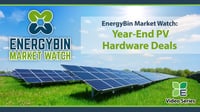 Learn about how sellers advertise year-end deals to clear their warehouses and attract new buyers.
Learn about how sellers advertise year-end deals to clear their warehouses and attract new buyers.
 Refer to this guide if you have used solar panels to assess whether you should resell or recycle them.
Refer to this guide if you have used solar panels to assess whether you should resell or recycle them.
3. Determine a reasonable marketing budget for the year.
Have you ever heard the expression, “You have to spend money to make money”? We wouldn’t be surprised if a marketing professional coined this phrase. Spending money to promote your brand – whether the expense is a trade show exhibit or an ad in a trade magazine or a webinar series – increases buyer awareness.
Promotions that educate buyers, addressing their needs and presenting your brand as a solution to their needs, help buyers move toward making a decision to do business with your company. Establishing an annual marketing budget allows your marketing team to create an integrated campaign that keeps your brand message in front of buyers all year long.
Note that marketing initiatives typically have a minimum of a 2-month lead time. For example, some trade show exhibitions sell out 9-12 months before the show dates. So, plan to finalize your budget well in advance of key initiatives.
4. Keep your customers happy.
Whatever you can do to make the buying experience as clear and straightforward as possible keeps your customers happy.
- How easy is it for a buyer to place an order with your company? Many of the largest solar distributors now offer online e-commerce portals for customers to log in and shop for what they need.
- What terms and conditions do you need to best serve customers as well as protect your company? Are they clear and simple to comprehend? Do you review terms and conditions with buyers in advance of contract signing?
- Do you communicate with customers throughout the order process? Do you follow up with them after delivery is made? Do you thank them for their business and ask for their feedback on how service can be improved for future orders?
 Read about how to expand your reach and enhance your customer experience.
Read about how to expand your reach and enhance your customer experience.
5. Get strategic about logistics and value-added services.
Logistics
Conduct a cost-benefit analysis to determine if it makes economic sense to partner with a logistics firm, own your transportation fleet or create a hybrid model. Review your analysis regularly as logistics expenses fluctuate and customer needs change.
Get quotes from freight brokers. Price can be extremely volatile from week to week in certain geographic areas due to seasonal freight production. Freight brokers do research to guarantee the best price, regardless of the ebb and flow of the market.
 Learn how freight brokers can help your company optimize logistics processes.
Learn how freight brokers can help your company optimize logistics processes.
Value-Added Services
Don't just preach the lowest price! The solar industry is intent on providing price feasibility and quality equipment. The lowest cost module is not always the best choice for the customer if it falls short of their energy requirements.
Many wholesalers have created business models with added services to provide a holistic experience for their customers, such as lines of credit, inventory storage, project financing, next-day and drop shipping, engineering design, site assessments, operations & maintenance services, and more. Create in-house departments, partner with other companies who specialize in these kinds of services, or implement a hybrid model to amaze your customers and set your company apart from your competitors.
 Read about how partnering with a financial broker can add value to your customer experience.
Read about how partnering with a financial broker can add value to your customer experience.
Tips for selling wholesale
1. Create a professional online presence for your business.
The Internet provides plenty of options to develop an online presence. Create a professional website for your company, list your company in online directories and create social media profiles. Include certifications, license numbers, trade association memberships, experience, third-party ratings and awards. You can also provide direct links to credential sources for buyers to easily verify your reputation.
An online presence consists of four main categories - a website, search engine optimization (SEO), inbound links and paid ads. All of these elements work together to promote your brand and attract prospective customers.
 Read more about how to incorporate these four elements into your online strategy.
Read more about how to incorporate these four elements into your online strategy.
2. Look for ways to expand your reach without breaking your advertising budget.
From trade shows to association memberships to webinars and the like, marketing opportunities are plentiful. But you don’t need to exhaust your budget by attending every show or advertising in every trade magazine. Put together a portfolio of initiatives that reaches your ideal customers (aka. buyer personas) and directs them to take the next step with your company (call-to-action).
Plan your initiatives to occur regularly throughout the year to ensure your message is consistently in front of your target audience. We recommend a mix of face-to-face networking like trade shows and digital content activities such as blogs, videos and webinars. To expand your reach further, partner with a trade association or magazine to feature sponsored content in their newsletter or to co-host a webinar. These initiatives come at a price, but they also generate immediate leads.
 Read more about how to maximize your investment of exhibiting at solar trade shows.
Read more about how to maximize your investment of exhibiting at solar trade shows.
3. Join an online B2B exchange to find new pre-qualified buyers.
Perhaps one of the most effective ways to connect with new pre-qualified wholesale buyers is to join an online B2B exchange. One of the solar industry’s leading global exchanges is EnergyBin, where PV professionals come together to buy and sell new, used, refurbished, and legacy solar equipment. Members collaborate to advance solar, share market intelligence and decrease costs.
Some exchanges are open to anyone. They tend to take a hands-off approach to liability. Others, like EnergyBin, are exclusive to registered solar companies. These companies must meet member qualifications and adhere to a code of conduct.
One of the biggest advantages of joining a B2B exchange is networking with buyers who are located around the world. Whether you're looking for ways to enter new foreign markets or to expand your international reach, a membership to an exchange is an affordable way to build relationships with companies outside your geographic area.
 Grow your network by using the tools available to you on EnergyBin.
Grow your network by using the tools available to you on EnergyBin.
Exchanges also offer a wealth of market intelligence. For example, on EnergyBin, members can access PV hardware trade data on price, availability, quantity, quality, location, buyer/seller contact information, and more. Often, this information tends to holder greater value and the products themselves.
 Read the PV Hardware Trade Analysis H1 2025 for a sample of market intelligence available on EnergyBin.
Read the PV Hardware Trade Analysis H1 2025 for a sample of market intelligence available on EnergyBin.
 Check out these key resources for U.S. companies who want to take on an exporting role.
Check out these key resources for U.S. companies who want to take on an exporting role.
 Read how an online reseller connects to new qualified buyers on EnergyBin.
Read how an online reseller connects to new qualified buyers on EnergyBin.
4. Be transparent in what you list for sale.
There’s nothing more frustrating for a buyer than learning that a listed product for sale is not available, does not match the advertised condition or varies in price from what is quoted. Strive for honesty and accuracy when advertising your products online.
When listing your products, whether on your website or in an exclusive exchange, include the details/specs, accurate descriptions of the condition, quality, quantity, price and product certifications.
Note that product certifications are necessary when listing on a global exchange because you don’t want to mis-lead another member into thinking that a product is rated for the United States, for example, when it is not. At the same time, you wouldn’t want to dismiss a member located in the U.S. for said product because their actual solar project may be located in another country. We have found this case to be common among EnergyBin members, who have main offices in the U.S. but are procuring equipment for projects around the world.
The risk you run by withholding information or being elusive about a product for sale is that you can quickly lose a buyer's trust. In the solar industry, relationships bear weight. If it gets around that your company is not trustworthy, it could be detrimental to your reputation.
 Review this quick guide for uploading your inventory to EnergyBin.
Review this quick guide for uploading your inventory to EnergyBin.
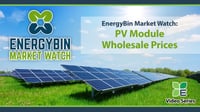 Get insights on PV module wholesale pricing and secondary market trends.
Get insights on PV module wholesale pricing and secondary market trends.
 Learn about best practices for buying & selling solar panels for resale.
Learn about best practices for buying & selling solar panels for resale.5. Build your credibility on- and offline.
One of the best ways to boost your credibility online is via customer quotes and case studies. When a happy customer gives you positive feedback about their experience, be ready to capture their story. Ideally, you would want to create a library of case studies and testimonials on your website for prospects to review as they consider working with your company. Present the content in a number of formats – videos, articles, short quotes, etc. – to make the message visible and easy to consume.
Google and Facebook reviews can also help. LinkedIn has a recommendation feature available on individual profiles, which may serve you and your employees well to have. Give a variety of options that make it easy for your satisfied customers to advocate on your behalf.
Once a prospect has heard about your company, reviewed your digital content and completed your online call-to-action, it’s time to take the relationship offline. Will the prospect get the same professional vibe on the phone that you presented on your website? How do you boost their confidence in that initial phone call that you’re worth doing business with?
Treat every phone call as your opportunity to make a stellar first impression. It doesn’t matter what a prospect has read about your reputation online if that same credibility doesn’t shine through on the phone. As soon as a one-to-one relationship begins, you need to work to earn their trust. Be patient. Oftentimes, early communications with a prospect are exploratory. Few prospects are ready to place an order when you first talk to them. Be prepared to answer their questions and offer your expertise, which reveals the value you bring to the table. Conclude each conversation by summarizing next steps, and follow up – do what you say you would do.
 Check out these tips for improving your trust level with your customers.
Check out these tips for improving your trust level with your customers.
 Another way to build your credibility is by sharing your expertise with your industry peers.
Another way to build your credibility is by sharing your expertise with your industry peers.
6. Reduce your risk by conducting due diligence on a prospective buyer.
Wouldn’t it be nice if you could sell to every prospect who wanted to buy from you? Sadly, it is not possible to be inclusive when it comes to buyers. As a company, you are charged with turning a profit, upholding organizational core values and reducing risk to minimize losses. The last thing you would want is to fall victim to fraud or have accounts default due to inability to pay.
Fortunately, today’s global economy is more connected than ever thanks to the internet. Taking the time to do online and offline due diligence will reduce your risk.
Online
- Look up a prospect’s business license with the appropriate governmental entity where they are located.
- If the prospect is a contractor, look up their license number information.
- Check the company’s rating on third party watch sites, like Better Business Bureau.
- Conduct a Google search on the company name. Doing so could reveal company news that may be alarming to you, such as open lawsuits or bankruptcy filings.
- If the company is publicly listed on the stock exchange, review their most recent financial statements.
Offline
- Interview the prospect:
- Get an overall sense of the company’s solar installation capacity and experience level.
- Ask for their credentials – license certificates, references, certifications, etc.
- Collect information on the project – who’s funding it, where is it, who designed it, what are the specs, how far along is it, have site evaluations been done, has permitting been approved, what is the project timeline, is it on track, what other partners are involved, etc.
- Ask for financial statements (income statements, balance sheets and profit/loss records).
- Get a copy of their most recent tax filing.
- Ask to see any existing contracts or partnership agreements.
- Confirm if the prospect is capable of meeting minimum order requirements.
7. Reduce your risk further by developing and communicating company policies.
Having a comprehensive policy document, also known as terms and conditions, protects your company from what-if scenarios that could result from a customer relationship. Such a document should be treated like a work-in-progress. There will be times when you choose to revise or add onto the document. It is wise to work with a business attorney to ensure the document is crafted in a way that would protect you in a court of law.
Some key policies that all wholesalers should consider developing include:
- Payment policy
- Return policy; restocking fee
- Comparison pricing
- Product availability and pricing
- Damaged product
- Product lost in transit
- Consignment
- Warehousing
- Incorrect product; unwanted or mis-ordered product
- Security interest
It is commonplace for companies to post terms and conditions on their websites, usually in the footer to make it easily accessible. Beyond that, integrate policy information into your communications with prospects, customers and employees. Plan to inform them regularly – both in writing and verbally – to ensure they are well aware of your policies.
8. If you are selling second-hand material, test the product and guarantee performance levels.
A number of wholesale buyers are purchasing second-hand material, especially modules, at megawatt levels. Quality used material with resale value is increasing in supply thanks to the repowering trend taking place throughout the U.S. and Europe.
If you are dealing in second-hand material, guarantee what you’re selling. A number of equipment resellers test used panels to guarantee product safety and verify amp and voltage performance levels. They reposition the product for sale in the secondary market, which may come with a limited-term service warranty. Some sellers offer a money-back guarantee based on a verified energy producing level.
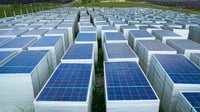 Learn more about two tactics - resale and donations - to re-deploy secondhand solar panels to communities in need.
Learn more about two tactics - resale and donations - to re-deploy secondhand solar panels to communities in need.
 Read about best practices that reputable resellers abide by when dealing with second-hand material.
Read about best practices that reputable resellers abide by when dealing with second-hand material.
 Read about the growing opportunity to remarket second-hand modules in the secondary market.
Read about the growing opportunity to remarket second-hand modules in the secondary market.
 Learn about what factors to consider to determine the resale value of decommissioned PV hardware.
Learn about what factors to consider to determine the resale value of decommissioned PV hardware.
9. Find ways to wow your customers and increase your profit margin.
From online shopping portals to drop-shipping to other value-added services, there are many ways to wow your customers. Of course, you’ll want to make sure every perk or service you offer is adding to your bottom line. If you can’t see a connection between the two, then it’s probably not worth doing.
Find ways to enhance your customers’ overall experience by collecting feedback from them. Don’t just send out general surveys. Call them and have a personal conversation. Customers will share more valuable information with you if you treat them in a personable manner.
In addition to the customer experience, take a hard look at a solar system’s project lifespan. There are numerous opportunities to create value from inception to end-of-life.
 Learn about secondary market solutions, including resale, solar panel and inverter remanufacturing, and recycling.
Learn about secondary market solutions, including resale, solar panel and inverter remanufacturing, and recycling.
 Read how these wholesalers have created a new revenue stream by remarketing excess equipment from other solar companies.
Read how these wholesalers have created a new revenue stream by remarketing excess equipment from other solar companies.
10. Form strategic partnerships with other companies to enhance your customer experience.
It may be tempting to try to be all things to all customers. But it won’t always be profitable to create in-house services. Before deciding to add another department to your operations, conduct a cost-benefit analysis. Consider strategic partnerships with other companies who are experts in their specialty areas. You may find a perfect partner to offer a new service that’s a more profitable arrangement than doing it on your own. Plus, partnerships allow you to stay focused on what you do best.
For example, if you are a master at selling solar equipment but lack the skills needed to design solar arrays, partner with a solar design engineer to create a value-added service to your customers.
Or, consider what partnerships you can form that provide secondary market solutions to your customers as their solar systems mature. Have a plan in place for PV repair, resale, and recycling to service your customers through system end-of-life.
You don’t need to know everything there is to know about solar. But you should know who you can contact in your network to fully satisfy your customers' needs.
 Read about how to network like a pro to stand out as a person worth knowing and doing business with.
Read about how to network like a pro to stand out as a person worth knowing and doing business with.
.jpg?width=200&name=From%20IT%20to%20PV%20-%20How%20an%20IT%20Reseller%20Switched%20to%20Solar%20(1).jpg) Learn how FabTech, a solutions provider for solar panel recycling and refurbishing, uses EnergyBin to form new partnerships.
Learn how FabTech, a solutions provider for solar panel recycling and refurbishing, uses EnergyBin to form new partnerships.
 Read about the state of solar panel recycling in North America.
Read about the state of solar panel recycling in North America.
Concluding remarks
Wholesale selling results in larger orders and increases the average order value, which in turn allows you to offer more attractive volume discounts. When paired with strategic marketing activities and value-added services, your company expands its reach and enhances your customer experience. Most importantly, wholesale selling helps to bring the cost of solar down, which accelerates the advancement of solar worldwide.
This guide will be frequently updated with additional information about wholesale selling for solar suppliers, distributors and brokers.
If you’d like to speak with a connection expert at EnergyBin about wholesale selling and available marketing opportunities on our B2B exchange, contact us today.
More Resources
 View more articles about wholesale solar equipment buying and selling.
View more articles about wholesale solar equipment buying and selling.


